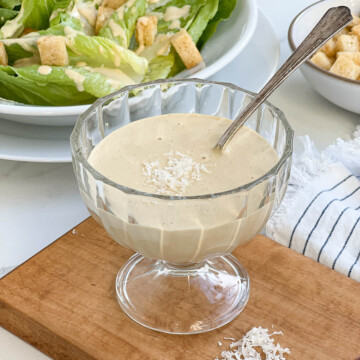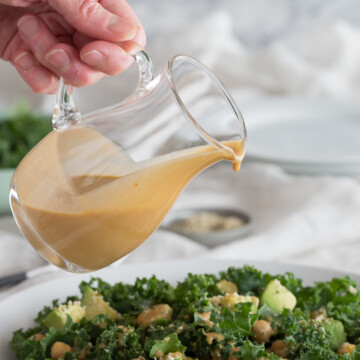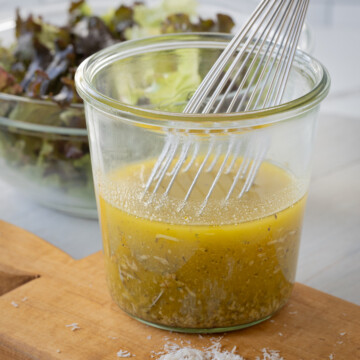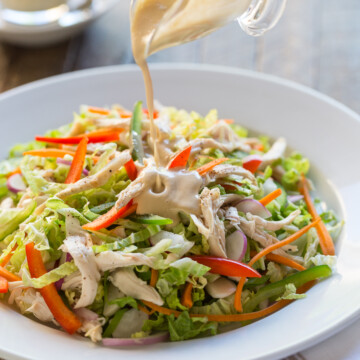A classic French vinaigrette is a staple for a reason. Made with just olive oil, vinegar, Dijon, and seasoning, it's the go-to salad dressing that comes together in minutes. But the real beauty? Once you learn the simple formula, you can mix and match oils, vinegars, and add-ins to create endless variations. Think of it as your vinaigrette recipe blueprint-reliable, flexible, and way better than anything in a bottle.

We eat salads all year round, but in summer they're on the table even more often. That's when a quick homemade vinaigrette like this really shines. This classic French vinaigrette is fresh and far better than bottled. Skip the preservatives and poor-quality oils. Make a small batch or scale it up for the week-you'll never go back to store-bought. And when it's this easy, why would you? Time to make your own vinaigrette.
Jump to:
Why You'll Love This French VInaigrette
- Simple ingredients - Made with just oil, vinegar, mustard, salt, and pepper (plus optional garlic), this dressing comes together in minutes.
- Customizable and versatile - Master the basic ratio and swap in different oils, vinegars, or seasonings to suit any salad.
- Better than bottled - No preservatives, cheap oils, or gums, just fresh flavor you control, every time. The perfect vinaigrette for salads.
Here's my recipe for a lemon vinaigrette if you are a lemon lover.
French Vinaigrette Ingredients

- Oil - Use a good extra virgin olive oil as your base. It adds richness and body. You'll find more oil options below for customizing your vinaigrette. My basics are California Olive Ranch and Calivirgin.
- Vinegar - Red wine vinegar is the classic choice for a French vinaigrette, giving it that signature tang. See below for other vinegar variations to change things up.
- Mustard - A creamy Dijon mustard helps emulsify the vinaigrette and adds just the right zip. It's essential for both texture and flavor.
- Garlic (optional) - A little fresh garlic goes a long way. Optional, but it adds subtle depth if you enjoy a garlicky finish.
- Shallot (optional) - Finely minced shallots add lovely flavor and texture to a simple vinaigrette.
Please see the recipe card for measurements, sea salt, and black pepper.
Substitutions and Variations

Changing up your oils and vinegars when making a French vinaigrette has almost endless possibilities! It's why I have 9 olive oils and as many vinegars (not kidding, that's the collection so far) in my pantry.
- Oil - Flavored olive oils like lemon, lime, blood orange, or basil add complexity. Nut oils (like walnut) also shine here. I love using the high quality flavored California-made oils from Calivirgin (no affiliation).
- Vinegar - In addition to red wine, champagne vinegar, sherry vinegar, rice vinegar, and of course apple cider vinegar, other good ones are white wine vinegar and white balsamic vinegar. I always keep a few fruit-infused vinegars like raspberry and blueberry on hand, as well as fig balsamic, and a good quality basic balsamic. Another much used favorite is a German apple cider vinegar. Each one brings something unique to the table.
- Mustard - Use good Dijon to emulsify and add flavor to a French vinaigrette. After traveling in France, I truly came to appreciate the difference. While smooth and creamy Dijon is my go-to for vinaigrettes, whole grain and flavored options like tarragon add their own delicious twists. My favorite: Edmond Fallot Dijon from Beaune, France is often ranked #1 in taste tests. Maille is another solid, more widely available brand in most grocery stores.
- If your vinaigrette is too tangy, add a pinch of sugar, a little honey or maple syrup.
Chef's Tip: Try swapping vinegar with fresh lemon juice, lime, or even grapefruit juice for a citrusy twist. You may need a little more juice than the standard vinegar ratio-just taste and adjust until it's bright and balanced.
For a simple raspberry vinaigrette, try the recipe in this grilled shrimp salad with fresh raspberries.
How to Make a French Vinaigrette
The best part about learning how to make a classic French vinaigrette is that once you know the formula, you'll never need a recipe again.

- Combine oil, vinegar, Dijon, garlic if using, salt, and pepper to a small bowl.

2. Whisk until smooth. Transfer to a jar.
Traditional technique says to slowly drizzle in the oil in a steady stream while whisking to form an emulsion-but honestly, I never do that. When you're making a small batch, good Dijon mustard handles the emulsifying for you. Just add all the ingredients to a bowl and whisk until smooth. It's the simplest way to make a homemade vinaigrette that's creamy, balanced, and full of flavor.
If you're making a small amount (enough for 2 to 4 people), whisk it directly in your salad bowl before adding the greens-one less dish to wash!
You can also combine everything in a jar with a tight-fitting lid and give it a good shake. Want a slightly creamier texture? Blend it for a smooth, emulsified vinaigrette in seconds.
Chef's garlic tips: Use a microplane zester to help raw garlic melt into the vinaigrette. It gives you that punch of flavor without any harsh bits of garlic. No zester? Mince, then mash the garlic with the side of your knife into a paste. Out of fresh garlic? A small pinch of garlic powder works-just let it sit in the dressing a few minutes to fully hydrate and bloom.

Serving Suggestions
I prefer to lightly toss fresh greens with just enough French vinaigrette to coat-never drenching. You can always serve extra at the table for those who like more dressing. Serve it at room temperature for the best flavor.
But don't stop at simple green salad! This classic vinaigrette brings bright, tangy flavor to pasta salads, bean salads, a beet salad with feta cheese (photo above) grilled or roasted vegetables, grain bowls, and more. Plus, it works beautifully as a marinade for chicken and seafood. It's one of those kitchen staples that's endlessly versatile and adds a punch of flavor wherever it lands.
Storing Vinaigrette
If stored in a sealed jar in the fridge, it will last up to a week. Always give it a shake or stir before using, and taste to adjust seasoning if needed.
Chef's Tip: Want to change it up? Add tender herbs like parsley, tarragon, or dill. Whisk them in for a burst of fresh flavor, or blend everything for a creamy, herb-infused vinaigrette with vibrant color. It's great on greens, veggies, or grilled chicken.

Recipe FAQs
The classic ratio is 3 parts oil to 1 part vinegar. That said, it's perfectly okay to adjust to your taste-some prefer a sharper, more acidic dressing and go closer to 2:1.
Yes, but the mustard helps emulsify the dressing and gives it that signature tang. Without it, your vinaigrette may separate more easily, so give it a good whisk or shake before serving.
Absolutely. Lemon juice makes a delicious, bright vinaigrette. You might need to use a little more than you would vinegar-taste and adjust as you go. And for even more lemon flavor use a little finely zested lemon zest, as that's where all of the essential oils are.
More Delicious Dressing Recipes
Did You Make This Recipe?
If you make this French Vinaigrette, add your comment and please give it a rating. I appreciate your feedback and enjoy hearing from you. They really help other readers. Any questions? Let me know.
📖 Recipe

French Vinaigrette
Equipment
- Small bowl
Ingredients
- 6 tablespoons extra virgin olive oil
- 2 tablespoons red wine vinegar vinegar options below
- 1-2 teaspoons Dijon mustard
- 1 small garlic clove optional, zested
- 2 pinches fine sea salt
- 2 pinches ground black pepper
Instructions
- Whisk together in a bowl or shake in a jar. For a larger batch use a blender for more of a creamy vinaigrette.





Comments
No Comments